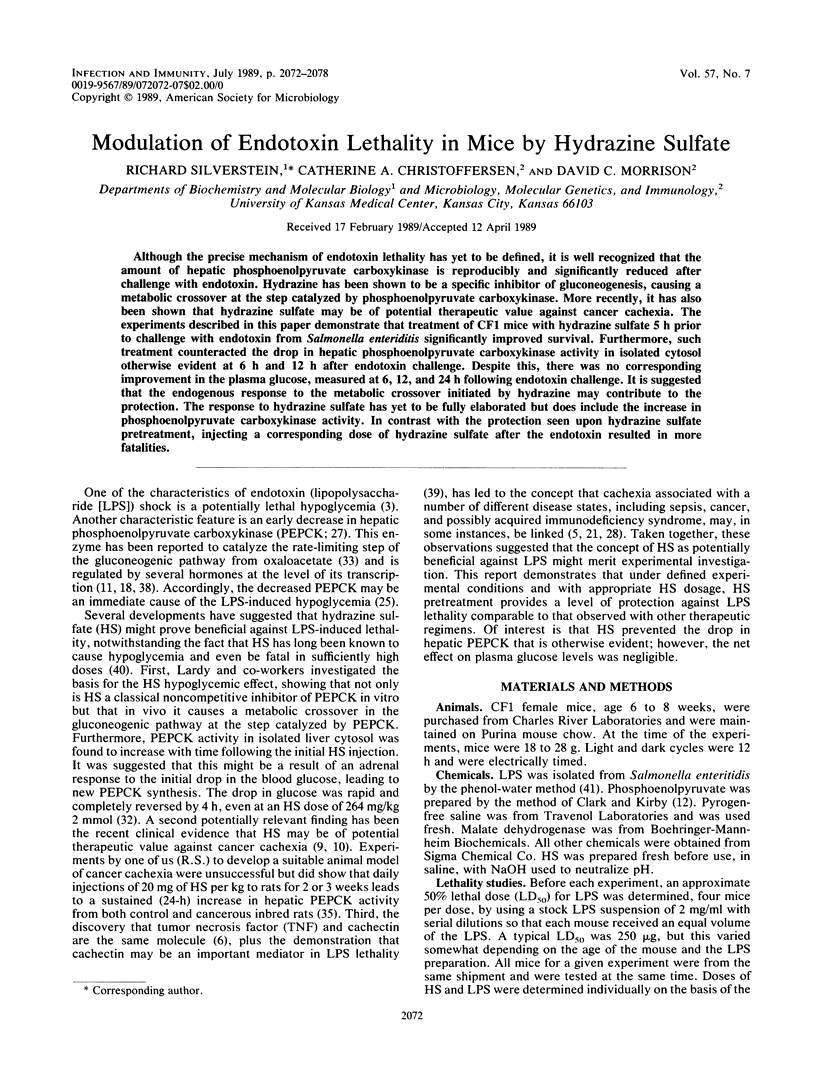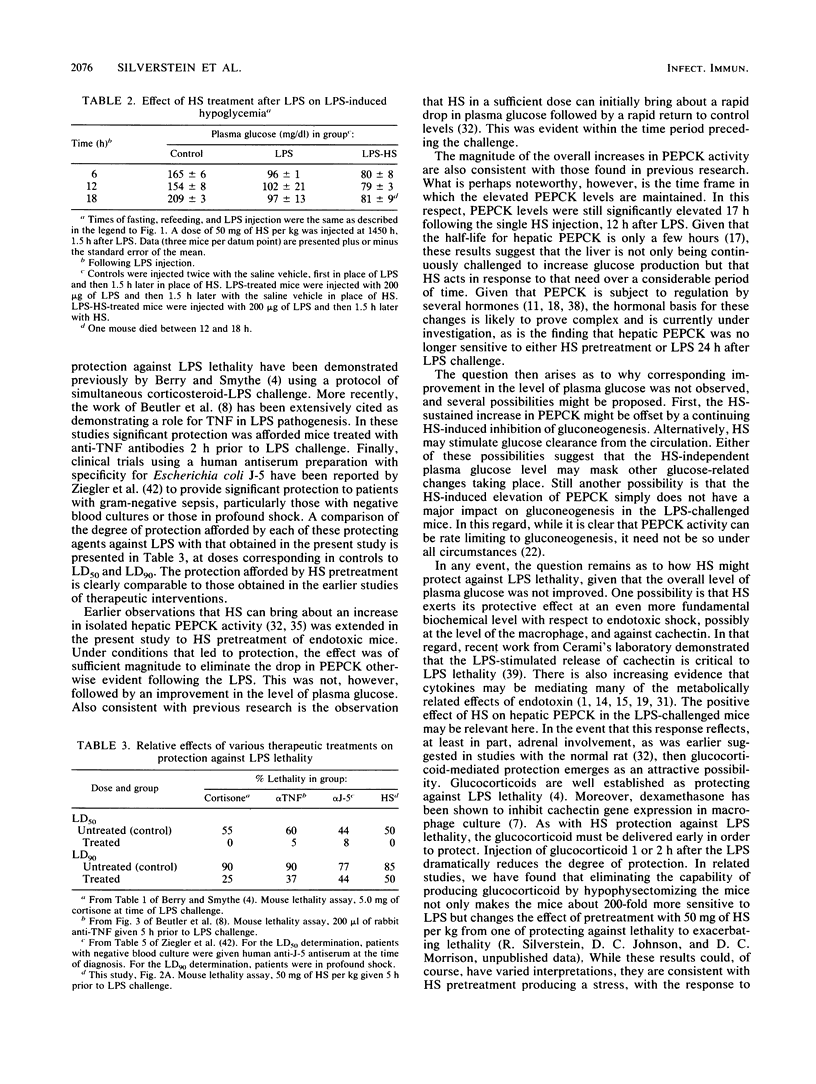Abstract
Although the precise mechanism of endotoxin lethality has yet to be defined, it is well recognized that the amount of hepatic phosphoenolpyruvate carboxykinase is reproducibly and significantly reduced after challenge with endotoxin. Hydrazine has been shown to be a specific inhibitor of gluconeogenesis, causing a metabolic crossover at the step catalyzed by phosphoenolpyruvate carboxykinase. More recently, it has also been shown that hydrazine sulfate may be of potential therapeutic value against cancer cachexia. The experiments described in this paper demonstrate that treatment of CF1 mice with hydrazine sulfate 5 h prior to challenge with endotoxin from Salmonella enteritidis significantly improved survival. Furthermore, such treatment counteracted the drop in hepatic phosphoenolpyruvate carboxykinase activity in isolated cytosol otherwise evident at 6 h and 12 h after endotoxin challenge. Despite this, there was no corresponding improvement in the plasma glucose, measured at 6, 12, and 24 h following endotoxin challenge. It is suggested that the endogenous response to the metabolic crossover initiated by hydrazine may contribute to the protection. The response to hydrazine sulfate has yet to be fully elaborated but does include the increase in phosphoenolpyruvate carboxykinase activity. In contrast with the protection seen upon hydrazine sulfate pretreatment, injecting a corresponding dose of hydrazine sulfate after the endotoxin resulted in more fatalities.
Full text
PDF






Selected References
These references are in PubMed. This may not be the complete list of references from this article.
- BERRY L. J., SMYTHE D. S. EFFECTS OF BACTERIAL ENDOTOXINS ON METABOLISM. VII. ENZYME INDUCTION AND CORTISONE PROTECTION. J Exp Med. 1964 Nov 1;120:721–732. doi: 10.1084/jem.120.5.721. [DOI] [PMC free article] [PubMed] [Google Scholar]
- Bauss F., Dröge W., Männel D. N. Tumor necrosis factor mediates endotoxic effects in mice. Infect Immun. 1987 Jul;55(7):1622–1625. doi: 10.1128/iai.55.7.1622-1625.1987. [DOI] [PMC free article] [PubMed] [Google Scholar]
- Beutler B., Greenwald D., Hulmes J. D., Chang M., Pan Y. C., Mathison J., Ulevitch R., Cerami A. Identity of tumour necrosis factor and the macrophage-secreted factor cachectin. Nature. 1985 Aug 8;316(6028):552–554. doi: 10.1038/316552a0. [DOI] [PubMed] [Google Scholar]
- Beutler B., Krochin N., Milsark I. W., Luedke C., Cerami A. Control of cachectin (tumor necrosis factor) synthesis: mechanisms of endotoxin resistance. Science. 1986 May 23;232(4753):977–980. doi: 10.1126/science.3754653. [DOI] [PubMed] [Google Scholar]
- Beutler B., Milsark I. W., Cerami A. C. Passive immunization against cachectin/tumor necrosis factor protects mice from lethal effect of endotoxin. Science. 1985 Aug 30;229(4716):869–871. doi: 10.1126/science.3895437. [DOI] [PubMed] [Google Scholar]
- Beutler B. The presence of cachectin/tumor necrosis factor in human disease states. Am J Med. 1988 Sep;85(3):287–288. doi: 10.1016/0002-9343(88)90575-x. [DOI] [PubMed] [Google Scholar]
- Chlebowski R. T., Bulcavage L., Grosvenor M., Tsunokai R., Block J. B., Heber D., Scrooc M., Chlebowski J. S., Chi J., Oktay E. Hydrazine sulfate in cancer patients with weight loss. A placebo-controlled clinical experience. Cancer. 1987 Feb 1;59(3):406–410. doi: 10.1002/1097-0142(19870201)59:3<406::aid-cncr2820590309>3.0.co;2-w. [DOI] [PubMed] [Google Scholar]
- Chlebowski R. T., Heber D., Richardson B., Block J. B. Influence of hydrazine sulfate on abnormal carbohydrate metabolism in cancer patients with weight loss. Cancer Res. 1984 Feb;44(2):857–861. [PubMed] [Google Scholar]
- Cimbala M. A., Lamers W. H., Nelson K., Monahan J. E., Yoo-Warren H., Hanson R. W. Rapid changes in the concentration of phosphoenolpyruvate carboxykinase mRNA in rat liver and kidney. Effects of insulin and cyclic AMP. J Biol Chem. 1982 Jul 10;257(13):7629–7636. [PubMed] [Google Scholar]
- Dinarello C. A. The biology of interleukin 1 and comparison to tumor necrosis factor. Immunol Lett. 1987 Dec;16(3-4):227–231. doi: 10.1016/0165-2478(87)90151-9. [DOI] [PubMed] [Google Scholar]
- Foster D. O., Ray P. D., Lardy H. A. A paradoxical in vivo effect of L-tryptophan on the phosphoenolpyruvate carboxykinase of rat liver. Biochemistry. 1966 Feb;5(2):563–569. doi: 10.1021/bi00866a023. [DOI] [PubMed] [Google Scholar]
- Goldberg A. L., St John A. C. Intracellular protein degradation in mammalian and bacterial cells: Part 2. Annu Rev Biochem. 1976;45:747–803. doi: 10.1146/annurev.bi.45.070176.003531. [DOI] [PubMed] [Google Scholar]
- Granner D., Andreone T., Sasaki K., Beale E. Inhibition of transcription of the phosphoenolpyruvate carboxykinase gene by insulin. Nature. 1983 Oct 6;305(5934):549–551. doi: 10.1038/305549a0. [DOI] [PubMed] [Google Scholar]
- Kawakami M., Pekala P. H., Lane M. D., Cerami A. Lipoprotein lipase suppression in 3T3-L1 cells by an endotoxin-induced mediator from exudate cells. Proc Natl Acad Sci U S A. 1982 Feb;79(3):912–916. doi: 10.1073/pnas.79.3.912. [DOI] [PMC free article] [PubMed] [Google Scholar]
- Kostos V., DiTullio N. W., Rush J., Cieslinski L., Saunders H. L. The effect of 3-mercaptopicolinic acid on phosphoenolpyruvate carboxykinase (GTP) in the rat and guinea pig. Arch Biochem Biophys. 1975 Dec;171(2):459–465. doi: 10.1016/0003-9861(75)90054-5. [DOI] [PubMed] [Google Scholar]
- LOWRY O. H., ROSEBROUGH N. J., FARR A. L., RANDALL R. J. Protein measurement with the Folin phenol reagent. J Biol Chem. 1951 Nov;193(1):265–275. [PubMed] [Google Scholar]
- Lardy H., Hughes P. E. Regulation of gluconeogenesis at phosphoenolpyruvate carboxykinase. Curr Top Cell Regul. 1984;24:171–179. doi: 10.1016/b978-0-12-152824-9.50023-x. [DOI] [PubMed] [Google Scholar]
- Lähdevirta J., Maury C. P., Teppo A. M., Repo H. Elevated levels of circulating cachectin/tumor necrosis factor in patients with acquired immunodeficiency syndrome. Am J Med. 1988 Sep;85(3):289–291. doi: 10.1016/0002-9343(88)90576-1. [DOI] [PubMed] [Google Scholar]
- McCallum R. E., Seale T. W., Stith R. D. Influence of endotoxin treatment on dexamethasone induction of hepatic phosphoenolpyruvate carboxykinase. Infect Immun. 1983 Jan;39(1):213–219. doi: 10.1128/iai.39.1.213-219.1983. [DOI] [PMC free article] [PubMed] [Google Scholar]
- Moldawer L. L., Georgieff M., Lundholm K. Interleukin 1, tumour necrosis factor-alpha (cachectin) and the pathogenesis of cancer cachexia. Clin Physiol. 1987 Aug;7(4):263–274. doi: 10.1111/j.1475-097x.1987.tb00169.x. [DOI] [PubMed] [Google Scholar]
- Moon R. J., Berry L. J. Role of tryptophan pyrrolase in endotoxin poisoning. J Bacteriol. 1968 Apr;95(4):1247–1253. doi: 10.1128/jb.95.4.1247-1253.1968. [DOI] [PMC free article] [PubMed] [Google Scholar]
- Moore R. N., Goodrum K. J., Couch R., Jr, Berry L. J. Factors affecting macrophage function: glucocorticoid antagonizing factor. J Reticuloendothel Soc. 1978 Apr;23(4):321–332. [PubMed] [Google Scholar]
- Morrison D. C., Ryan J. L. Endotoxins and disease mechanisms. Annu Rev Med. 1987;38:417–432. doi: 10.1146/annurev.me.38.020187.002221. [DOI] [PubMed] [Google Scholar]
- Ray P. D., Hanson R. L., Lardy H. A. Inhibition by hydrazine of gluconeogenesis in the rat. J Biol Chem. 1970 Feb 25;245(4):690–696. [PubMed] [Google Scholar]
- Rognstad R. Rate-limiting steps in metabolic pathways. J Biol Chem. 1979 Mar 25;254(6):1875–1878. [PubMed] [Google Scholar]
- Silverstein R., Lin C. C., Fanning K. W., Hung B. T. Inactivation and modification of phosphoenolpyruvate carboxykinase differentially labeled with bromopyruvate. Biochim Biophys Acta. 1980 Aug 7;614(2):534–544. doi: 10.1016/0005-2744(80)90242-9. [DOI] [PubMed] [Google Scholar]
- Stith R. D., McCallum R. E. Failure of glucagon to induce hepatic phosphoenolpyruvate carboxykinase in endotoxic shock. Circ Shock. 1988 Nov;26(3):267–272. [PubMed] [Google Scholar]
- Tracey K. J., Fong Y., Hesse D. G., Manogue K. R., Lee A. T., Kuo G. C., Lowry S. F., Cerami A. Anti-cachectin/TNF monoclonal antibodies prevent septic shock during lethal bacteraemia. Nature. 1987 Dec 17;330(6149):662–664. doi: 10.1038/330662a0. [DOI] [PubMed] [Google Scholar]
- Ziegler E. J., McCutchan J. A., Fierer J., Glauser M. P., Sadoff J. C., Douglas H., Braude A. I. Treatment of gram-negative bacteremia and shock with human antiserum to a mutant Escherichia coli. N Engl J Med. 1982 Nov 11;307(20):1225–1230. doi: 10.1056/NEJM198211113072001. [DOI] [PubMed] [Google Scholar]
- del Rey A., Besedovsky H. Interleukin 1 affects glucose homeostasis. Am J Physiol. 1987 Nov;253(5 Pt 2):R794–R798. doi: 10.1152/ajpregu.1987.253.5.R794. [DOI] [PubMed] [Google Scholar]


